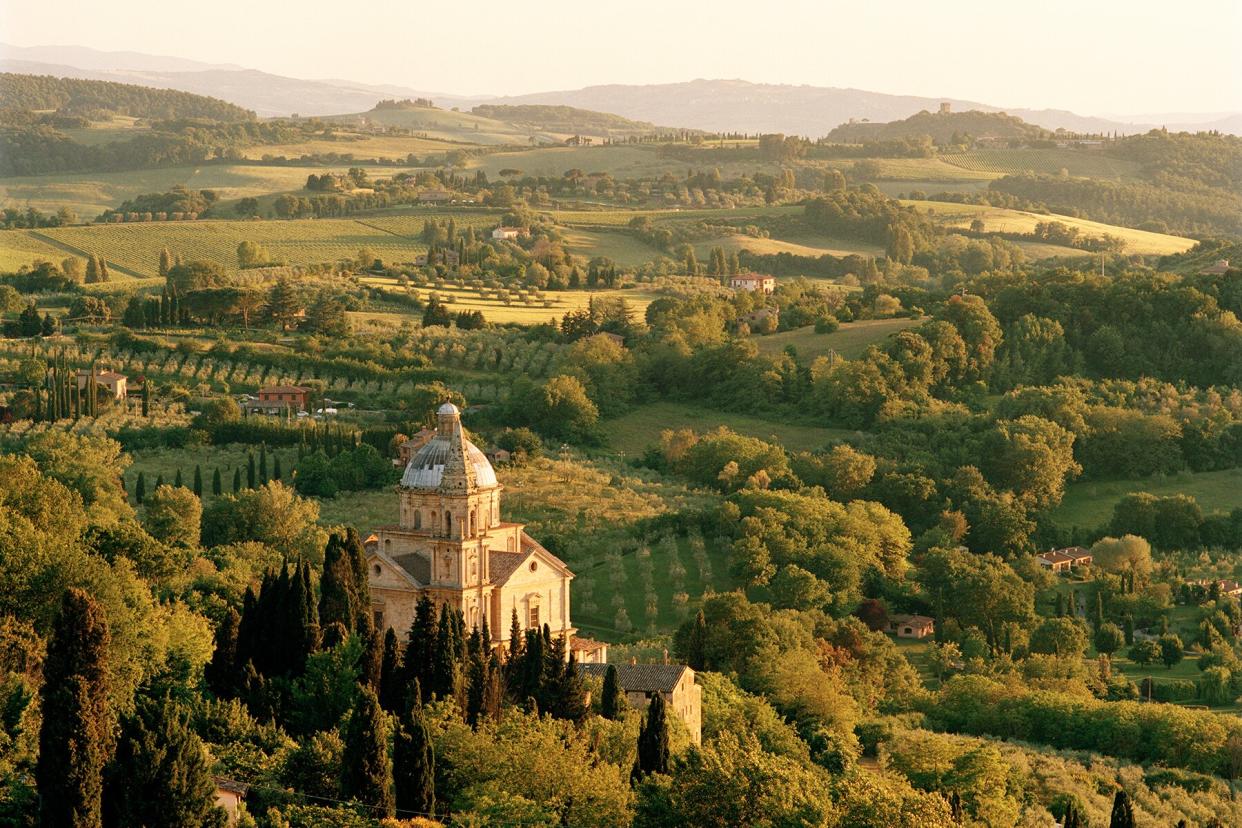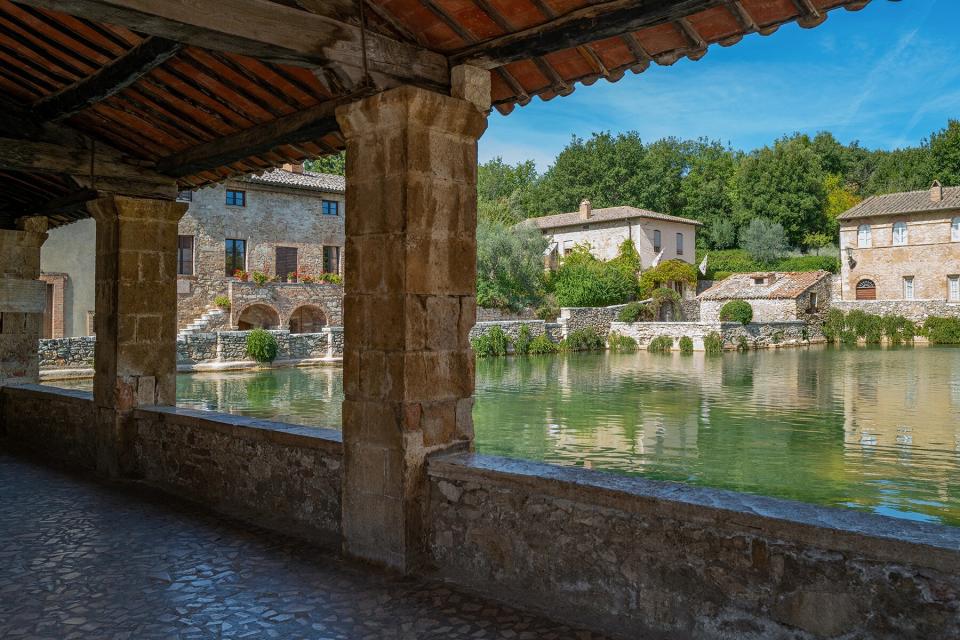I Traveled to Tuscany During the COVID-19 Pandemic — Here's What It Was Like

Gary Yeowell/Getty Images
It's no secret that the whole of Italy was hit hard by COVID-19. Between March 2020 and May 2021, travelers were kept out of the country while it went into lockdown. Since Americans and other travelers have been returning to the country, rest assured that Italy — and from my experience, especially Tuscany — is still as beautiful and bucolic as it used to be.
Deciding to take the big leap into traveling again isn't easy after over a year and a half at home. Living in New York City, an original "center" of the pandemic, also meant that I was acutely aware of the risks even though life in many ways had evolved into a new normal here.
Tuscany has always held romance for people; between the tall cypress trees that dot the landscape and the hilly mountain towns, it's no wonder so many travelers dream of one of Italy's largest regions.
I am a fully vaccinated traveler who stayed in private Airbnbs in Italy for two weeks. My family members, who have been within my "bubble" for the entirety of the pandemic, were my travel companions. Traveling during COVID-19 is always a risk, therefore it's necessary to always observe all local restrictions and laws in regards to the pandemic, including mask mandates and social distancing where possible.
Related: My Family Rented an Italian Villa to Reunite During COVID — Here's What It Was Like

George Pachantouris/Getty Images
Why Tuscany Was the Best Part of My COVID-era Trip to Italy
During my two-week trip to Italy, I stayed not only in Tuscany, but also in larger and more popular tourist destinations like Rome and Venice. While traveling to both of those cities, I noticed the number of travelers was starkly different than the Medieval and Renaissance towns nearby where we stayed for more than a week. In Rome in October 2021, streets were packed with travelers and locals alike (including some protesting vaccine mandates in the country). At times, the Spanish Steps were covered in people, and walking through the city felt a little like Times Square. The smaller towns of Tuscany, however, told a different story.
American travelers, strangely enough, were not as easy to come by once you got out of the cities, though there were some other than myself and the party I was with. We stayed near San Quirico d'Orcia, which is in the province of Siena –– a very well-traveled part of Tuscany before the pandemic. Although the city of Siena is slightly larger and was more populated with travelers, the smaller, hillier towns like Montalcino, Montepulciano, San Quirico, Montichiello, and Pienza were fairly quiet.

Masci Giuseppe/Getty Images
If you're an American who wants to see the beauty of the Italian countryside with slightly less of a risk, getting an Airbnb or hotel in one of these small towns is highly recommended. And frankly, it's these towns that stand to gain the most from tourist dollars right now since many of the local shops, bars, restaurants, and accommodations are in need of the hospitality industry to return in order to keep their local populations. Losing people to larger cities (where they can find more industry) is a common problem in these villages.
How to Enter Italy From the U.S.
Right now, all U.S. travelers must be vaccinated (or have documentation of their medical reason not to be vaccinated) and produce a negative COVID-19 test that was performed less than 72 hours before departure. The PCR test is generally preferred, but it also holds an inherent risk of results not coming back in time. The best way to avoid this is to find a testing center that can guarantee a 24-hour turnaround. Otherwise, a rapid antigen test is also permissible. In addition, U.S. travelers must fill out a Digital Passport Locator form before heading to the airport.
While going through customs, travelers still need the basic paperwork, such as a passport, to enter the country. While in the country, U.S. citizens must also arrange to do another COVID-19 test, either rapid antigen or PCR, through a local testing center –– usually a pharmacy in whichever city they're staying in last. A rapid test costs about $20 and a PCR test costs about $70.
The Italian government has a color-coded system for measuring COVID-19 risk by region. White means "very low risk," yellow means "low risk," orange means "high risk," and red means "very high risk." (Tuscany was white at the time of publish.)
What It's Like to Stay in an Airbnb in Italy
Finding a great Airbnb in Italy is easy and sometimes can be a little less expensive than booking a hotel. However, checking hotel rates against Airbnb booking rates is always recommended.
For us, our villa in Tuscany was like a dream home. It had several bedrooms with private bathrooms, a large kitchen and dining area, and a back yard dotted with cypress trees. It was a little more relaxing at the end of the day since we were in a private space that only the owner of the home could access other than our travel party. While staying at an Airbnb in a large city like Rome doesn't impact your ability to get around, there are a lot of Airbnbs in Tuscany that are located outside the city center. Luckily, getting around and exploring several towns in the area is easy if you rent a car.
Keep in mind, however, that many foreign countries (including Italy) do not recognize U.S. driver's licenses –– so it's important to get an International Driver's Permit (IDP) from somewhere like AAA and keeping your rental paperwork with you just in case you get pulled over. Italians drive on the right side of the road, making it easy for U.S. travelers to navigate, so using an app like Google Maps is also highly recommended.

Apostoli Rossella/Getty Images
What to Do in Tuscany Right Now
Much like the rest of Italy, Tuscan towns are operating as much and as safely as possible. While you don't have to wear a mask while walking outside, going into shops, bars, restaurants, museums, and other indoor attractions require everyone to wear a mask (unless you're seated at a table in a restaurant, for instance). Italy also uses a "green pass" where you can store all your information on your phone –– but U.S. travelers can also present their I.D. and vaccination cards.
Even in the fall, Italy can be perfectly pleasant and sunny during the day, but gets somewhat chilly at night. While we dined out for dinner most nights, Tuscany was also the perfect place for us to hire a chef to come into the home to teach us how to make pici, a pasta variety that Tuscany is known for. Hiring a home chef also requires everyone to be vaccinated.
Restaurants, bars, and shops are operating normally at the moment, with the exception of requiring masks while indoors. Museums and attractions usually require a timed-entry reservation, where you'll also need to go through security to check your vaccination cards, I.D., and any bags you might have. If you visit Montepulciano and Siena, there are famous towers that allow travelers to do a challenging, steep climb –– but you'll be greeted by astonishingly beautiful, 360-degree views of hills and local vineyards at the top. Other towns will have gorgeous churches and fortresses that are also open for tourists to explore, though most attractions require an entrance fee.
Tuscany is also well known for its expansive vineyards, so arranging a wine tasting or winery tour is also a wonderful way to experience Italian culture. Most vineyards can also arrange tours in English if needed. For my trip, we arranged tastings at the Castiglion del Bosco winery near Montalcino, and Salcheto Winery near Montepulciano.

Courtesy of Andrea Romano
Tips for Planning Your Trip to Italy During the COVID-19 Pandemic
Arrange all your paperwork. Get a paper copy of your COVID-19 test results and keep your I.D., passport, and vaccination card all in an accessible and safe place. Before you go to the airport, be sure to also print out your Digital Passport Locator form and present it when you check in.
Learn some Italian. While a lot of people in Italy, especially popular tourist destinations, speak some English, you'll always run into someone who may not –– and if you want to communicate clearly, it's best to try to speak the language of the country you're in.
Pack comfortable shoes (plus one or two backup pairs). Tuscany, like parts of Rome, is also in the hills, and you'll encounter a lot of sleep climbs and uneven cobblestones no matter where you are. Be sure to take care of your feet, because most places are very pedestrian once you're in the city, and the fabulous vistas are always much more enjoyable when you're comfortable. You might also want a poncho, rain jacket, or umbrella.
Ask your hotel concierge or Airbnb host for the best place to get your COVID-19 test before your leave (or any other travel tips). Since they're locals, they'll have all the best knowledge on getting around.
Check with your wireless provider about travel options. Some companies will charge you for using data in a foreign country, but that also gives you peace of mind that you'll be able to stay in touch and use apps like Google Maps with ease. Otherwise, purchasing or renting a mobile Wi-Fi hotspot is a good way to save a little money while also staying connected.
Always check the CDC website and the U.S. Embassy for information on returning home.
Wear your mask indoors and always be respectful of local restrictions and customs.

